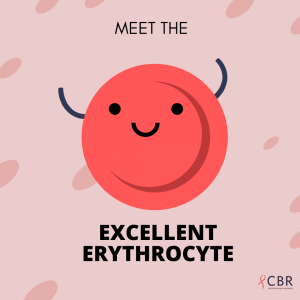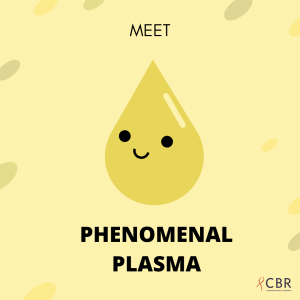Science Literacy Week, which takes place annually in September, is an outreach initiative that aims to highlight the diversity of Canadian science and the interesting, innovative scientific work that researchers are working on across the country.
In 2020, invited our audience to #MeetTheBloodCells on our Instagram, Twitter and Facebook. We introduced five blood components, all of which help keep our bodies healthy and strong.
You can meet these blood cells below:
 |
For #SciLit week, we’d like to introduce you to some important blood cells who help keep your body healthy and strong. To start off, meet the Excellent Erythrocyte, also nicknamed the Red Blood Cell or RBC! With the help of a protein called hemoglobin, the Excellent Erythrocyte carries oxygen from your lungs to the rest of your body, and also returns carbon dioxide from your body back into your lungs. The Excellent Erythrocyte actually gets their beautiful, bright red colour from hemoglobin, and are the most common type of blood cell in the blood. What makes the Excellent Erythrocyte special? Unlike lots of other cells, the Excellent Erythrocyte has no nucleus, allowing them to easily change their shape and travel through blood vessels of different sizes in your body. Talk about a great traveler! Keep an eye out for other blood cells, who will be making an appearance throughout Science Literacy Week!
|
 |
Say hello to Phenomenal Plasma, another component in the blood that we’re featuring for #scilit week! While technically not a “blood cell”, Phenomenal Plasma still plays an important role. Phenomenal Plasma is the liquid part of the blood, made up of a mixture of different substances like water, fat, protein, and salts. Their main job is that of a transporter, moving blood cells through your circulatory system, as well as things like nutrients, waste products, antibodies, clotting proteins, chemical messengers like hormones, and more. When separated from the rest of the blood, Phenomenal Plasma appears light yellow in colour. Most of your blood is actually composed of plasma – it makes up approximately 55% of your blood’s volume! In healthcare, Phenomenal Plasma is a bit of a superstar. When you donate blood, healthcare providers can isolate important components in plasma – such as antibodies – and eventually use them in treatments for serious health problems. That’s phenomenal!
|
 |
Our #SciLit Week feature today is the Terrific Thrombocyte, affectionately called “Platelet” by their friends. Like Phenomenal Plasma, the Terrific Thrombocyte is not actually a “blood cell”. In fact, the Terrific Thrombocyte is made of small fragments of cells, which help your body form blood clots to stop bleeding. If you get a cut or a wound, you can rely on the Terrific Thrombocyte to come to the rescue, gathering around the injury to help plug it up. This process of “plugging up” a wound is also called coagulation. Under the microscope, the Terrific Thrombocyte normally looks like an oval-shaped plate, hence their nickname “Platelet”. However, if you catch the Terrific Thrombocyte in action while they’re plugging up injuries, their shape changes and they seem to grow “arms” that help form blood clots and stop the bleeding. How neat is that?
|
 |
Today for #SciLit week we’re featuring the Noble Neutrophil, a member of the Leukocyte Family (AKA the White Blood Cell Family)! As a white blood cell, the Noble Neutrophil helps keep your body safe by defending it against infectious organisms, and is often the first one there at a site of infection. How does the Noble Neutrophil get rid of pesky microorganisms that cause infections? By consuming them! As a big eater, the Noble Neutrophil helps destroy infectious microorganisms by engulfing them through a process called phagocytosis. The Noble Neutrophil belongs to a group of white blood cells called granulocytes. Other granulocytes are the Noble Neutrophil’s siblings, the Energetic Eosinophil and the Bold Basophil, who also help your body’s immune response to things like allergies or parasites.
|
 |
Our final #SciLit week feature is the Brilliant B Cell! The Brilliant B Cell is a member of the Leukocyte Family (AKA the White Blood Cell Family) and belong to a group of white blood cells called lymphocytes. Part of their job is to patrol your body and look out for invaders. Once they spot something that doesn’t belong, like a virus or dangerous bacteria, the Brilliant B Cell creates Y-shaped molecules called antibodies that “stick” to these invaders. Sometimes these antibodies help destroy the invader directly, and other times they act as “flags” that tell other cells to recognize and destroy the invader. Did you know that the Brilliant B Cell has a great memory? After an invader is destroyed, the Brilliant B Cell helps your body remember information about the threat. By doing this, your body can respond more quickly and effectively if an invader ever returns. Thanks for keeping us safe, Brilliant B Cell!
|


